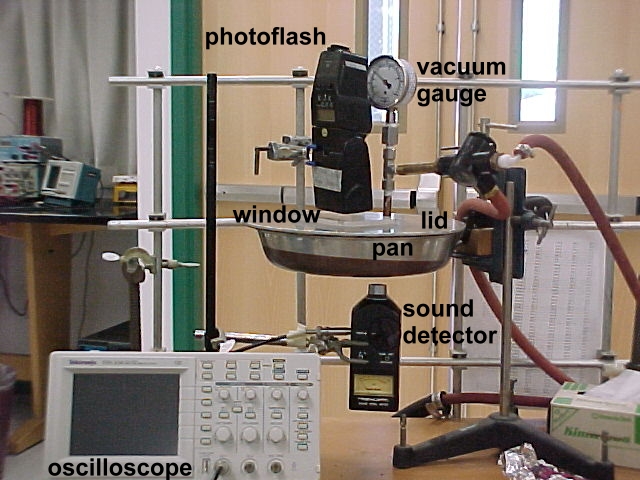Experiment of The Month
In search of radiation momentum
Light carries momentum and energy as it travels. The energy is easily detected as heat when an object absorbs it. The momentum is not so easily detected. A demonstration which suggests that it detects radiation momentum was brought to us by Dr. Nolan from his experience at Stanford.
The demonstration uses simply a camera photoflash and a steel frying pan. The flash is activated a centimeter or two from the pan, and the pan rings as though it had been tapped with a wooden spoon. Senior physics major Andrew Sensenig took on the task of sorting out this effect for his senior seminar project.
It is clear from the sound that a force is exerted on the pan, and therefore it absorbs momentum. The problem is to identify the source of the momentum. Besides radiation momentum, the momentum could come from the air in contact with the pan. It could also come from differential heating of the metal in the pan. It could come from a sound wave associated with the "pop" that the flashlamp makes. Finally, it could arise from material ablated from the pan by the heat from the light flash.
The pan rings when the lamp flashes through transparent plastic, but not when the light is blocked by carbon paper. The sound of the flash does not cause the sound in the pan.
Mr. Sensenig began with order-of-magnitude tests. From the manufacturer's specifications and from battery lifetime he made two separate estimates of the amount of energy in one the light from one flash. In both
From
Next, he rigged a lid with a window to make the interior of the frying pan into a vacuum chamber. When the light was flashed through the window, the sound was reduced with decreasing air pressure. The decrease was less than 50%. If air were the only source of momentum, the sound intensity would fall to zero in a vacuum. Changing the gas from Nitrogen to Helium did not significantly change the sound intensity. The heating and recoil of the air near the surface is a contributor, but not the major source of
Andrew also attached a small thermometer and measured a temperature rise of several tenths of a degree Celsius. This is the correct order of magnitude of temperature rise for a segment of the pan about 20 square cm in
Plating the pan with silver had a negligible effect on the intensity of the sound. The sooty pan did generate more sound when the air pressure was high, indicating that heating of the air was significant. When the air was removed, the sooty pan and the shiny pan produced about the same sound intensity.
Finally, he measured the motion of the pan by gluing a bit of mirrored plastic film on the bottom and reflecting a laser beam from it, at an angle of 45 degrees. A split detector measured
The mirror on the pan could be made to move towards or away from the side where the light was flashed. When the light was flashed directly opposite to the mirror, the mirror moved away from the light. Other flash locations could make the mirror move towards the light. The presumed cause is the generation of more complicated drum head modes in the pan bottom, by the off-center impact of the light.
The tentative conclusion is that radiation pressure plays a role in the generation of sound in the pan.
